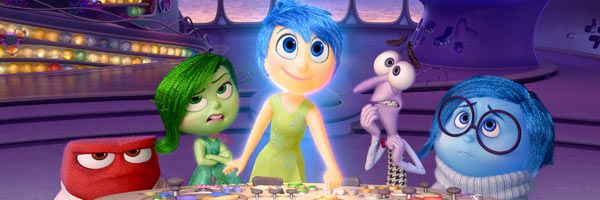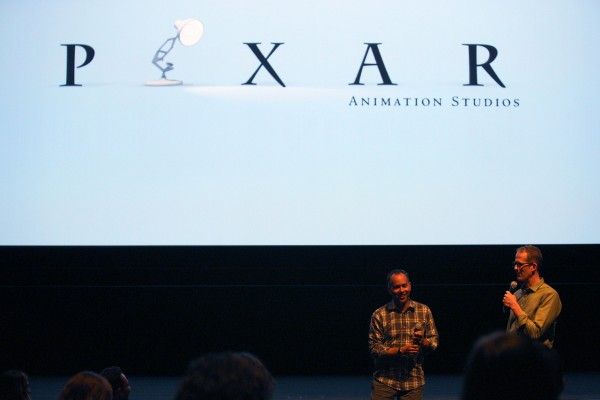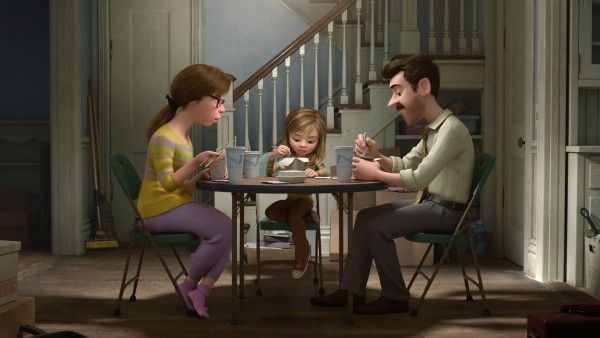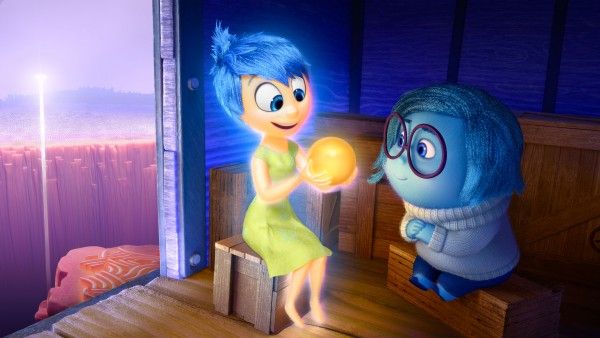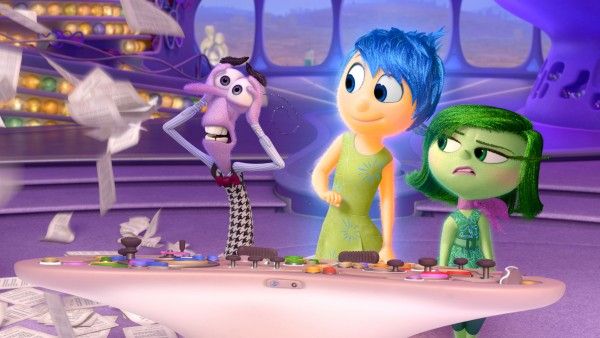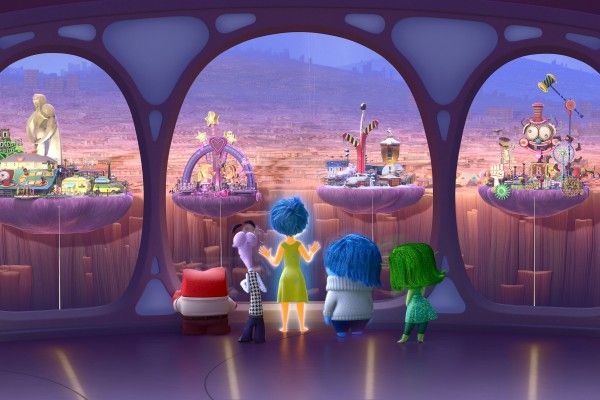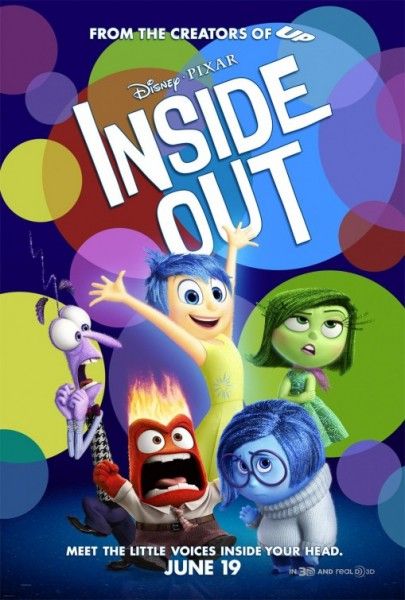I’m down to watch anything created by the folks at Pixar, but, to be honest, I’ve been a bit skeptical about their upcoming feature Inside Out. There’s definitely something ingenious about getting a peek inside the mind of an 11-year-old and personifying her emotions, but could the idea sustain a full feature? If the emotions are in fact single emotions, how can they experience any sort of character arc? And what about the connection between the real world and the mind world? Could the movie move seamlessly from one to the other?
I’ve spent a good deal of time trying to figure out how the filmmakers could pull it off, but now I’m officially done questioning the movie’s potential because I had the opportunity to visit Pixar and see 56 minutes of it and I suspect it could be one of Pixar’s best yet. Clearly I can’t call it a favorite until I see the third act, but the first two definitely have me hooked and eager to see the rest of it.
After a screening of James Ford Murphy’s stellar short film Lava (click here to check out my interview with Murphy from October), director Pete Docter and producer Jonas Rivera stepped out to introduce the Inside Out footage. They briefly discussed how Docter’s growing daughter inspired elements of the film and highlighted the extensive amount of research they did during development. Docter noted, “This whole world is made up so we wanted to base it in as much truth as possible.â€
Inside Out is specifically about a young girl who’s struggling after her family moves out of her childhood home in Minnesota and into a townhouse in San Francisco, but absolutely anyone can relate to how she’s feeling thanks to the way her emotions handle the situation.
Here’s a spoiler-free breakdown of the footage shown. I’ll share more from my visit to Pixar including interviews with the filmmakers over the next few weeks. (Note: Keep in mind, this is only a reaction to the first 56 minutes of the film.)
The Real World Characters
Riley (Voiced by Kaitlyn Dias): She’s an 11-year-old girl who had a blast growing up in Minnesota. She had great friends, was a star hockey player, loved goofing around and had an especially close relationship with her parents, but the move to San Francisco ruins just about all of it. We’ve seen kids get bummed about leaving childhood homes before, but what makes Riley’s experience unique and deeply touching is how the movie internalizes it. Every single one of Riley’s reactions is thoughtful and justified because you get to see her - or rather, her emotions - spark those responses. However, they’re not just making the decisions for her. The emotions are Riley and Riley is her emotions and the seamless intercutting between the mind world and the real world does a spot-on job conveying that they are one and the same, a quality that makes Riley’s growing pains far more meaningful than most.
Mom & Dad (Diane Lane & Kyle MacLachlan): There’s nothing particularly novel about Riley’s parents. Dad was once attentive to the max but after the move to San Francisco, work takes precedence over family time. Luckily mom’s still around though. There isn’t much she can do to make Riley feel better about the move, but she is there to help - when Riley lets her. During the visit to Pixar, a good deal of the filmmakers spoke about conveying complex concepts in a short period of time and the cookie cutter versions of mom and dad are actually necessary to achieving that. In one single scene (the dinner scene shown in the first full length trailer), the movie brings the concept of personified emotions to a new level by comparing Riley’s emotions to the emotions inside the minds of a stereotypical mother and father.
The Mind World Characters
Joy (Amy Poehler): When we first met Joy in the film’s marketing material, I got a little nervous. It seemed like there was a good chance that the character’s unrelenting optimism might actually wind up being a bit off-putting, however, Poehler really pulls it off beautifully. The folks behind the film said this a number of times throughout the day, but Poehler is Joy. Even though Joy can be loud, hyper and happy, happy, happy, all the time, Poehler makes it feel natural. And perhaps even more impressive, she also manages to let Joy’s composure crack here and there without ever losing sight of the fact that she is that emotion. Joy is also Riley in a way. There’s this interesting element of the dynamic between a team of emotions and their person where a different emotion can be in charge in each person (something you can read more about in the Docter and River roundtable interview). Inside Out firmly establishes Joy as emotion #1 in Riley right from the start so when you see less of Joy coming through Riley as the film progresses, it amplifies the changes she's experiencing.
Sadness (Phyllis Smith): I’m surprised to say this, but I think Sadness is my favorite emotion. You’ve got five main characters - Joy, Sadness, Fear, Anger and Disgust. Who would ever want to say anyone but Joy is their favorite? But Inside Out does one heck of a job shedding some positive light and conveying that you really do need all of the emotions, even the more negative ones that you might want to avoid in everyday life, especially Sadness.
Fear, Anger & Disgust (Bill Hader, Lewis Black & Mindy Kaling): After Joy and Sadness accidentally get sucked up the memory tube and shipped off to longterm memory, it’s up to Fear, Anger and Disgust to keep things running. Needless to say, they have a tough time figuring out who should take charge and, as a result, we see Riley behave in very erratic ways. Based on what we saw in the first 56 minutes of the film, Fear, Anger and Disgust aren’t as rich as Joy and Sadness, but all three are still key to the group dynamic and contribute quite a bit of humor to the film as well.
Bing Bong (Richard Kind): Say hello to my second favorite character in Inside Out, Bing Bong. He’s Riley’s imaginary friend who basically becomes a hobo when she grows out of playing with him. He’s easily one of the goofiest Pixar characters out there, an odd combination of elephant, dog, cotton candy and more, but he’s also one of the most poignant elements of the film. Whereas life for the emotions will change as Riley matures, Bing Bong is almost entirely forgotten. It is rather heartbreaking, but Inside Out also puts up a strong case when trying to sell that even the faintest memories from our past still contribute to who we are today.
The Mind World
HQ: This is home base for the emotions. They use the console to guide Riley through her day, they collect memories, keep an eye on Riley’s core memories and at night, one emotion is put on dream duty while the others sleep. It’s a fun, bright, dynamic space that serves as an effective introduction to the emotions and their responsibilities before opening up the story to other locations in Riley’s mind.
Personality Islands: There are tons of incredibly clever locations in Riley’s mind, but the personality islands are a favorite. The core memories power different aspects of Riley’s personality and in her mind they’re represented as islands. There’s hockey island, friendship island, goofball island, honesty island and family island. As you’ll notice in some of my interviews, I had a good deal of fun considering what my own might be and asking the filmmakers about theirs as well. (For the record, I think I’ve settled on family, movies, sports, pets and tech.)
Longterm Memory: At the end of each day, the emotions ship the collected memories off to longterm memory where they’re maintained by The Forgetters, these small, blue bubble-like creatures who decide which ones are faded to the point of being forgotten and must be thrown away.
The Train of Thought: This one’s a bit self-explanatory, but the Train of Thought is the primary means of transportation in Riley’s mind, so when Sadness and Joy are stranded in longterm memory, they come to the conclusion that the train is the best way to make it back to HQ.
Imagination Land: Imagination Land feels a bit like an amusement park. It’s where all of Riley’s wildest dreams come true. There’s a french fry forest, trophy town, cloud town and, a personal favorite, a machine that spits out an imaginary boyfriend.
Dream Productions: Dream Productions is basically a movie studio for dreams. It looks a lot like Paramount Pictures and is packed with Forgetters who create Riley’s dreams much like a crew shoots a movie.Â
Overall Reaction
I adore the large majority of Pixar movies, but haven’t seen one that hits home quite like this since Toy Story. For lack of better terms, Inside Out is something the whole family can enjoy. Kids will have a blast with the cute characters and their goofy behavior, but the narrative will register on a deeper level as well, offering a unique perspective on what happens when you don’t get your way and how to handle it. And the same is true for adults, too. Clearly there aren’t living, breathing emotions running around inside our heads, but there’s a good deal of truth to how Docter and his team approach the inner workings of the mind. In fact, it’s therapeutic in a way. It can be all doom and gloom when you’re dealing with a tough situation, but if you reconsider with the thought that joy, sadness, fear, disgust and anger all work together, it’s uplifting and motivating. Again, I can’t dub Inside Out a home run without seeing the third act, but there’s absolutely no doubt that the film is on the right track.
Click here to check out the new Inside Out stills and concept art, and be sure to keep an eye out for more from my visit to Pixar coming soon.

